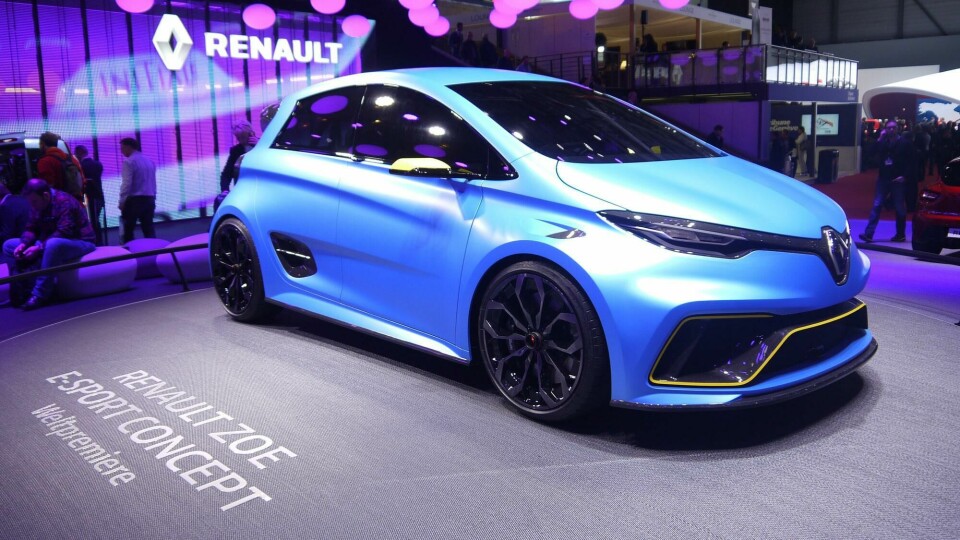
Geneva 2017: Anthony Lo on Renault’s design progress
Car Design News catches up with Anthony Lo as Renault introduced its electric Zoe e-Sport concept
CDN caught up with Anthony Lo, Renault's vice president of exterior design, at the Geneva show, as the French brand unveiled a one-off, four-wheel-drive sports car based on the humble Zoe electric car.

CDN: What is the thinking behind the Zoe E-Sport electric car?
Anthony Lo: It’s a car that we designed purely for fun. We started with the Zoe body, we widened it and put on wide tyres for grip, and put in twin motors front and rear. We were inspired by Formula E technology. There’s a lot of horsepower, and it will do 0-100km/h in 3.2 seconds. The ratio of power to weight is actually better than a Formula E car.
This is thanks to our knowledge and experience in EV technology, since we were one of the first companies to launch a line-up of affordable EV products.

CDN: Zoe still looks remarkable fresh four years on...
Lo: When I joined the company in 2010 it was roughly at the end of its design phase. It’s still a very modern car. Some of its features are unique but it was not deliberately made different to the rest of the range just to show that it’s an electric car.

CDN: Do cars like the Scénic and Espace have a future, given the ongoing march of the SUV?
Lo: This trend of SUVs you can’t avoid. We have to be part of it because it’s the fastest growing part of the B, C and D segment. That it is why we have the updated Kadjar and are bringing the Koleos to Europe.
At the same time, the Scénic and Espace are icons for the brand. They look super futuristic. We think they’re really important to keep for the brand.
One of the reasons people like crossovers so much is that they look more robust, and more stable on their bigger diameter tyres, so this is exactly what we did with the Scénic. But rather than following traditional SUV cues we created a sexy sporty minivan.
CDN: Wasn’t it a risk putting such large wheels on a people mover? Potential customers may misjudge its scale and so underestimate its ability to move people...
Lo: It does look smaller than it is. The big story of that car is to maintain the roominess but also to make it attractive.
We actually offer a steel wheel in the 20-inch diameter, the biggest steel wheel any car manufacturer supplies. I’ve seen only a couple on the road so far – most sell with high-end wheels.
We came up with the solution of using add-on plastic parts for the alloy wheels because of the need to strike a balance between weight and aerodynamic performance. We optimise the actual metal part of the wheel to the minimum, and then we cover with plastic add-ons. The weight of the wheel is very similar to that of a good 18-inch wheel. So we got to 20-inches without a weight penalty. It’s a really good compromise, so the stance of the car, everything can be optimised for these wheels.
CDN: Renault is also carving out quite a presence for its cars with expressive lighting signatures. What is the thinking there?
Lo: We have to find something original that we can call our own, so we have to be bold. So we've put part of the signature outside the headlamp – we call it ‘out of the box’ internally – and of course everybody was a bit surprised in terms of engineering, safety, and so on, but I think the more we do it, the more we realise what we can achieve with new technology. The goal is to make it identifiable, from a hundred metres away, that it’s a Renault.

CDN: Congratulations on winning CDN’s Concept Car of the Year award for the Trezor. Will we ever see any elements of the Trezor design vocabulary make the jump to road cars – hexagonal patterned surfaces, say?
Lo: I would call Trezor a celebration after we worked very hard for several years. We wanted to showcase [the fact] that we’re not going to stop where we are. We’re going to keep experimenting and look for new ideas. Whether it’s a surface treatment or a light signature – trying to see how far we can go. Concept cars are not something you design knowing what you’re going to do with it. It’s a snapshot of ideas, and afterwards, you see what you can do with it.



